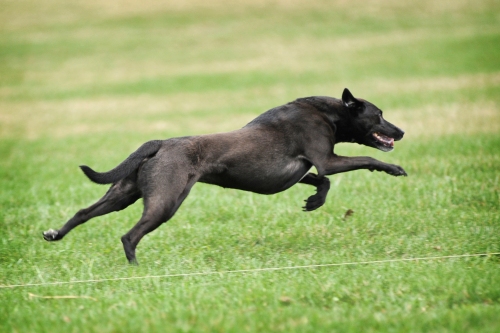Trout stands in the kitchen, head and stumpy tail down, back hunched. She doesn’t feel well, and she hasn’t felt well for quite awhile. Her symptoms are frustratingly vague for all their severity. She has episodes of gastric reflux severe enough that she attempts to stop the discomfort by eating whatever she can reach – licking fur off the carpet, swallowing grass, and most dangerously of all, chewing and swallowing pieces of cloth and stuffing from her dog bed or toys. She’s had several impaction scares, but as yet has managed to pass everything. She trembles occasionally and stretches constantly, trying to find a comfortable position. Her stomach rumbles and gurgles (a symptom called borborygmos, which seems appropriate). To add insult to injury, she has a raging urinary tract infection
She’s being treated by an internal medicine specialist, and we’re hopeful that we’ll figure out what’s making her feel so poorly in the next few weeks. In the meantime, she’s on a regimen of medications to manage her symptoms. Antibiotics, cranberry supplements, fish oil pills, famotidine, probiotics, tramadol, and sucralfate all keep her comfortable. She’s not an easy dog to medicate, though, as her appetite is poor. Luckily for her, I have some tricks up my sleeve, and the two of us have history together.

Like all puppies who come to live with me, Trout has been conditioned from an early age to accept medication. I start right away with puppies, opening their mouths only to pop a bite of hot dog or chicken onto their tongue. I restrain them gently, handling them all over their bodies as they lick peanut butter off a spoon. They lick baby food from syringes, and learn to be comfortable with the restraint positions necessary for blood draws.
All of this prep work is easy to do, and the results have a lifelong benefit. Every dog will need medication at some point in their life, whether it’s antibiotics for a minor infection or pain pills as their joints get old and creaky. We prepare our dogs for life by teaching them to come when called, walk nicely on a leash, and greet people appropriately. Why not also teach them to be comfortable taking medication and being examined by a veterinarian?
This idea is par for the course in the exotic animal world. You can’t hold an uncooperative dolphin or elephant down, and if you try to restrain a wild prey animal like a gazelle it may go into shock and die from the stress. No one wants to shove a pill down an uncooperative tiger or hyena’s throat! Animals in zoos and aquariums are prepared for medical procedures as part of their daily training, and I strongly believe in doing the same thing for our pet dogs. Just because we can get away with holding dogs down to get stuff done doesn’t make it right, and restraining a dog for the sake of expediency is always a losing battle in the long run as it just makes future vet or grooming visits more difficult.
One of Trout’s medications needs to be given at least two hours before and after food, which means that we can’t wrap it in anything delicious. The pill gets dissolved in water, then the slurry is squirted down her throat with a syringe. She’s not a fan, but she cooperates. She gets this medication every eight hours, so in between doses she gets two or three syringe-fulls of baby food. Since the delicious syringes outweigh the icky ones, she continues to accept medication with no complaints.
Pilling her also requires a bit of forethought. She’s compliant about letting me shove a pill down her throat if it’s necessary thanks to plenty of practice having treats popped into her mouth after I open her jaws. However, it’s always better to get compliance, so I try wrapping the treats in delicious food first. So far braunschweiger (a pork liver spread) is a clear winner, and she takes even the most bitter pills wrapped in a pea-sized smear of this. Canned food, cottage cheese, yogurt, hot dog pieces, Easy Cheese, and commercial Pill Pockets have also been effective in getting her to take her medication.
Like many dogs, Trout can be a bit tricky. She’ll take the pill wrapped in something else, but then spit the pill out and swallow the treat. If your dog likes to pull this trick, try feeding multiple small “treat balls” in a row. Feed a small bit of the wrapping (yogurt, braunschweiger, etc.) by itself, then a bit with the pill, then another bit or two with nothing in it. If you feed these quickly enough, your dog will be so focused on the next treat that she won’t notice the pill (or at least won’t have time to spit it out).
Trout’s a rock star about all of this care, but not all dogs are. If your dog is especially difficult to medicate, you can ask your vet about getting the medication compounded. A pharmacist will mix the medication with chicken, salmon, beef, or other flavor so that your dog thinks it’s a delicious treat. This seems to work especially well for bitter medications, and while it does add some cost to your prescription it may be worthwhile for the reduced stress on you and your pet. This works for cats too!
Note: I’ve had several friends and clients ask if they can help with veterinary expenses, which have climbed to almost 12.5% of my yearly income in the last month alone. If you’d like to donate, you can do so here through PayPal or here through the GoFundMe site. Your positive thoughts, prayers, white light, and other good vibes are also very appreciated. I feel a bit weird accepting donations, but Dobby’s costs last year depleted my savings account to such an extent that I’m incredibly grateful for your offers to help. I’m always amazed at what a supportive, caring community the dog world is. It’s a wonderful, warm feeling to know that people all over the world are pulling for my little white dog. Thank you!






